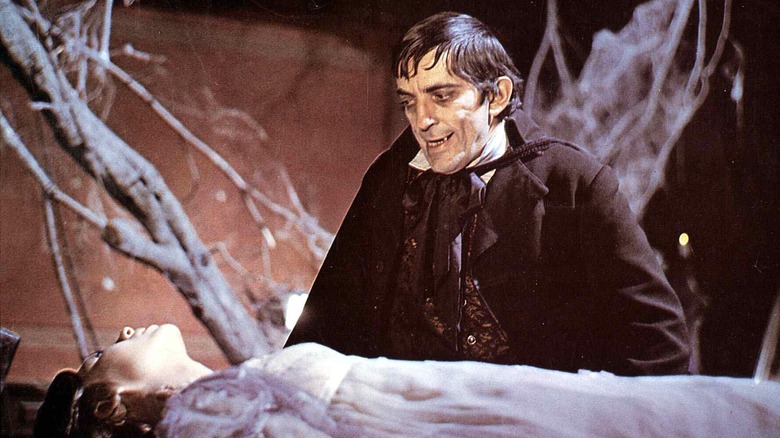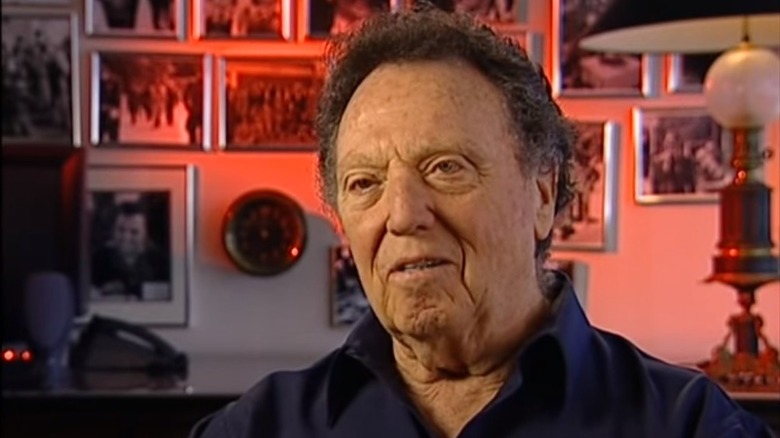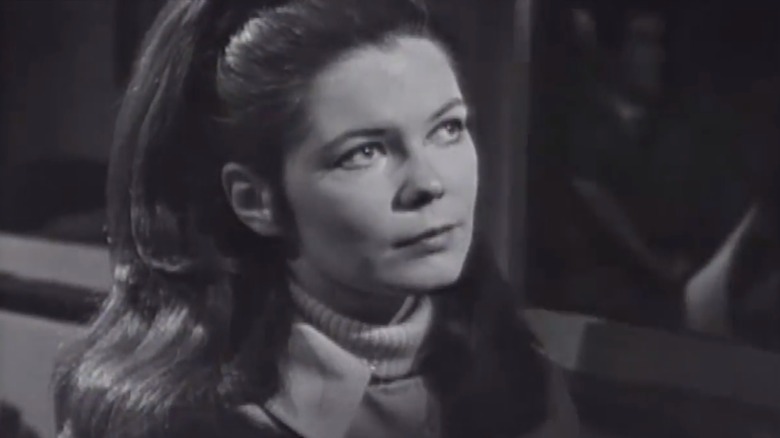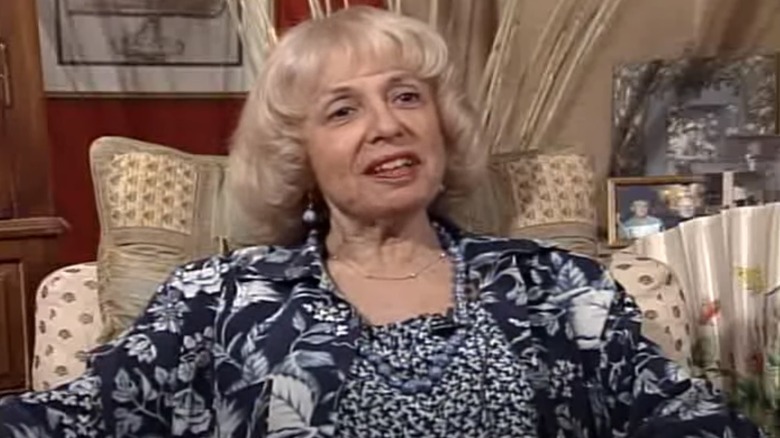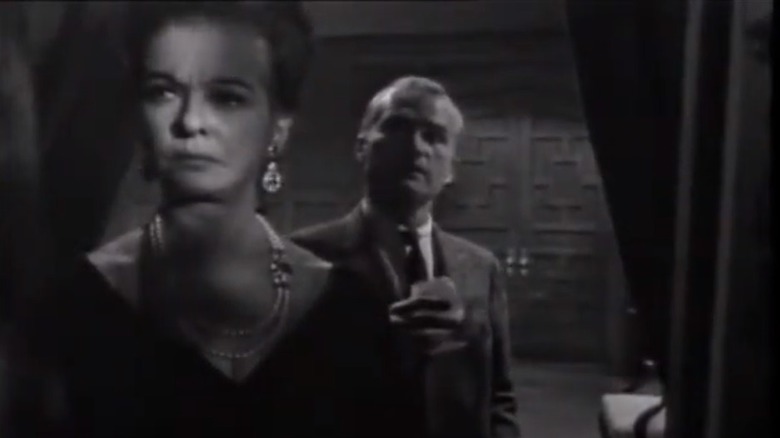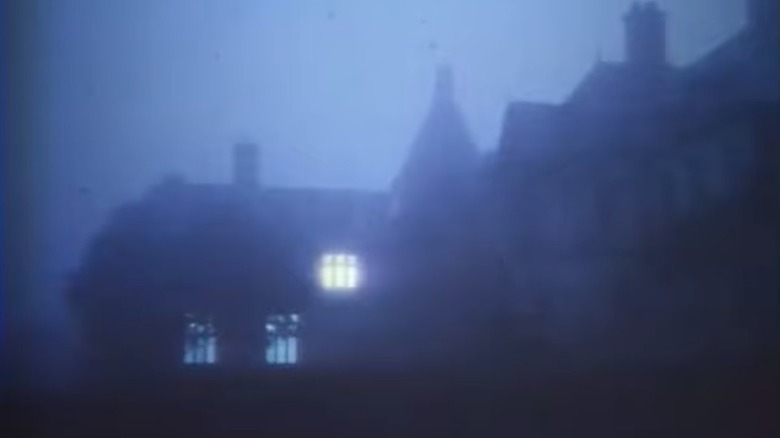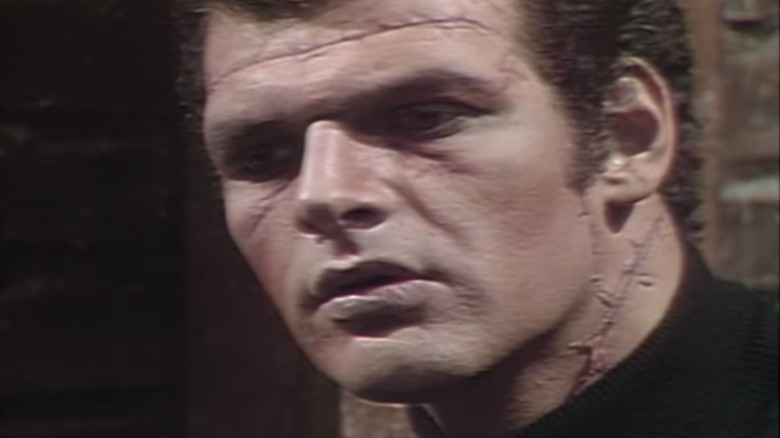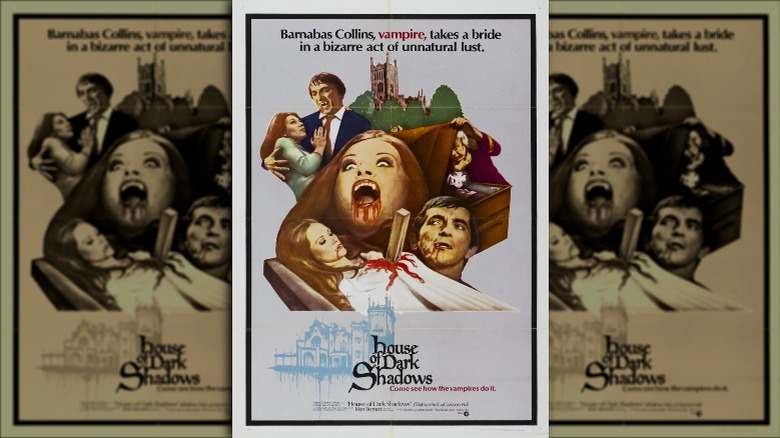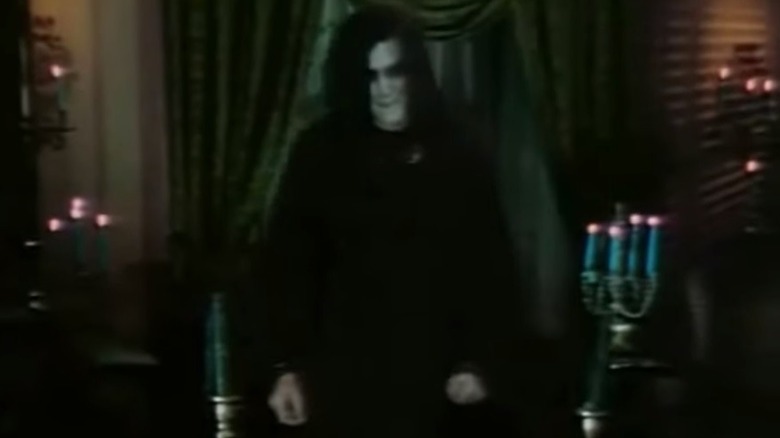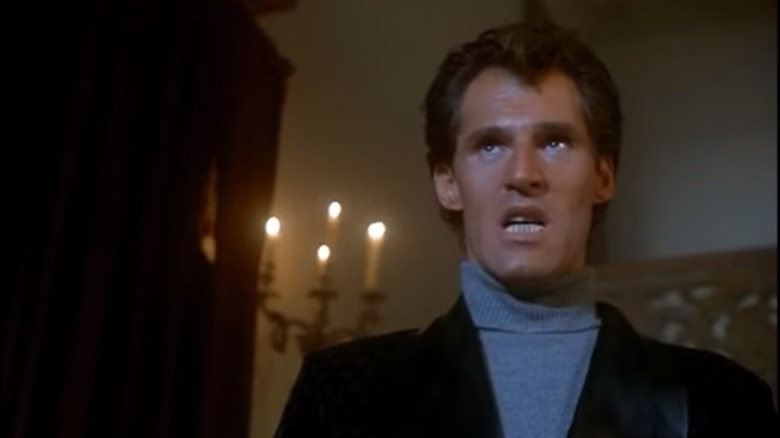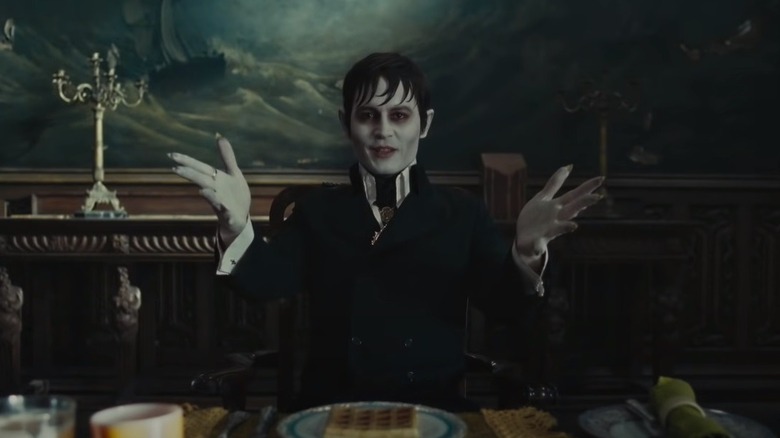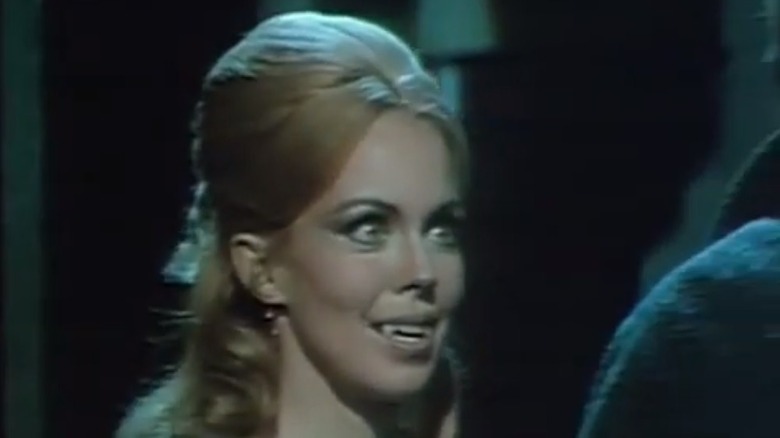Dark Shadows: The Untold Truth
Although daytime television soap operas have largely become a relic of a bygone era of broadcasting, notes Newsweek, (only four are currently in production as of 2021), there was a time when they ruled the airwaves. From the 1950s through the 2000s, dedicated viewers thrilled to the lives, loves, tragedies, and triumphs of their favorite characters on such serials as "Guiding Light," "As the World Turns," and "All My Children." Often focusing on the lives and struggles of rich and powerful families, soap operas were the height of melodrama with addictive storylines that often spanned for years. Often unfairly maligned as mere vicarious fantasies for bored housewives, soaps nonetheless found fans across demographic lines.
By the 1960s, many of the most popular soaps, some of which had begun on radio, were already cultural institutions. Tried-and-true stock storylines of romance and personal conflict ruled the format. However, in 1966, a new soap opera appeared on the ABC television network that would upend the status quo. Combining the Gothicism of "Jane Eyre" with elements of the supernatural and horror movie tropes, "Dark Shadows" chronicled the life of Victoria Winters, a young woman raised in a foundling home who became a governess for the mysterious Collins family in hopes of discovering the facts of her past. With storylines centering on vampires, werewolves, ghosts, and time travel, the show rose above its competition to become a pop culture phenomenon. This is the untold truth of "Dark Shadows."
Dan Curtis: the king of TV terror
As documented in a supplemental interview featured on the "Dark Shadows — The Complete Original Series" DVD collection, creator Dan Curtis' first success was as the creator and producer of "The CBS Golf Classic." Still, Curtis longed to tell stories. He was finally able to satisfy his creative bent in 1966 when he sold "Dark Shadows" to ABC.
The success of the gothic horror soap allowed Curtis to further pursue his career as a writer, producer, and director. More genre hits would follow, making Curtis the king of made-for-TV horror in the 1970s. His next big success as a producer was the 1972 telefilm "The Night Stalker." With a script by legendary horror author Richard Matheson (based on "The Kolchak Tapes," by Jeff Rice), the film starred Darren McGavin as Carl Kolchak, a harried newspaper reporter who stumbles upon a vampire in Las Vegas. "The Night Stalker" was followed by a sequel titled "The Night Strangler," which pitted Kolchak against an immortal killer stalking the Seattle Underground. The films garnered unprecedented ratings. Curtis would also produce successful TV versions of the horror classics "The Picture of Dorian Gray," "Dracula," and "The Turn of the Screw."
In 1975, Curtis re-teamed with Matheson and writer William F. Nolan for "Trilogy of Terror." Directed and produced by Curtis, the film stars Karen Black in three stories. It's most notorious segment, "Amelia," which features Black locked in a one-woman battle against a murderous Zuni fetish doll, remains nightmare fuel for a generation.
Dark Shadows was inspired by a nightmare
The success of "The CBS Golf Classic" made Dan Curtis a bankable TV producer. Soon, Curtis, who had struggled to make ends meet just a few years before, was earning $100,000 per year.
Looking to move away from sports programming, Curtis consulted with his friend Ed Graham, the producer-director of the popular animated show "Linus! The Lion-Hearted," about a live action project on which they could partner. As documented in "The Television Horrors of Dan Curtis," Graham suggested a weekly series based on the DC Comics property "Batman." Although Curtis successfully pitched the show to CBS, a shake up at the executive level prevented it from going into production at the time.
In the summer of 1965, Curtis had a nightmare that would prove monumental. "I saw a girl with long, dark hair," Curtis told "16 Magazine" in 1970. "She was about 19, and she was on a train that stopped in a dark, isolated town. She got off the train and started walking and walking. Finally, she came to a huge, forbidding house. ... At the door, she lifted a huge brass knocker and gently tapped it three times. I heard a dog howl, and then — just as the door creaked open — I woke up!"
Obsessed with this vision of a latter day Jane Eyre, Curtis pitched the show, then titled "Shadows on the Wall" to ABC. Rechristened "Dark Shadows," Curtis' Gothic soap opera premiered on June 27, 1966.
Lela Swift, the woman at the helm of Dark Shadows
To realize his vision for "Dark Shadows," Dan Curtis handpicked a team of behind-the-scenes professionals. First, he hired veteran TV writer Art Wallace to flesh out his nightmare into a story that would support an ongoing series. Curtis himself would serve as executive producer, handing day-to-day production duties to line producer Robert Costello. Set designer Sy Tomashoff was brought on to design the eerie Collinwood mansion, and composer Robert Cobert was hired to write the "Dark Shadows" atmospheric theme.
To direct his Gothic soap, Curtis hired a true television pioneer. Lela Swift began her career in television in the 1940s as a member of the CBS secretarial pool. As documented in a Paley Center for Media bio, Swift was a protégé of Frances Buss Buch, television's first woman director. Swift rose through ranks from gopher to assistant stage manager. In 1948, she joined the CBS drama anthology "Studio One" as assistant director. Swift would go on to direct "Studio One" and other shows, including "Suspense" and "The Web," where, as the Paley Center notes, she gave James Dean his start. Soon she was the only woman directing live dramas during TV's golden age.
Swift directed nearly half of "Dark Shadows" 1,225 episodes. In 1975, Swift signed on as a director of the long-running daytime soap "Ryan's Hope." Swift directed "Ryan's Hope" for nearly 14 years garnering three daytime Emmy Awards for her work. Swift died in 2015 at the age of 96.
Dark Shadows was nearly canceled in its first year
As detailed in "Barnabas and Company," by Craig Hamrick and R.J. Jamison, "Dark Shadows" was largely devoid of the supernatural elements that made it a hit for much of its first year. Focusing on Gothic imagery and mystery, the first episodes mostly followed Alexandra Moltke's Victoria Winters as she searched for clues to her past. Although Collinwood was referred to as a haunted house, the ghosts were, at first, more metaphorical than literal. "'Dark Shadows' is best remembered as a supernatural thriller ...," Hamrick and Jamison write. "But in the beginning, the scariest thing on the screen was the tacky blonde wig Kathryn Leigh Scott was forced to don for her first few outings as waitress Maggie Evans."
Critics found "Dark Shadows" debut episode a bore, and ratings were dismal. "We didn't catch on," creator Dan Curtis explained. "... As we got past the first 13 weeks, I knew we were going to be history. We weren't going to make it." At the suggestion of his children, Curtis decided to "make the show scarier" and throw caution to the wind. Curtis said, "No one's ever done anything like this. I'll let it rip.
Curtis' addition of a ghost to the storyline came with a small but noticeable bump in the ratings. "Then I finally decided, 'Well let's see how far I can go with this thing,'" Curtis recalled. "... When we put the vampire on ... the ratings went through the roof!"
Enter the vampire, Barnabas Collins
Although the appearance of the centuries old vampire Barnabas Collins heralded a positive change for "Dark Shadows," and his storyline came to dominate the plot, the character was never intended to be a major part of the show let alone the hero. "The plan was never, of course, to use him beyond sticking a stake in his heart," Curtis said in a video interview. "[Barnabas] was supposed to be a true marauder. He was Dracula. He was a bad guy."
As detailed in "Barnabas and Company," Curtis cast a Canadian stage actor with virtually no television experience named Jonathan Frid as the Collins family's tortured, blood-drinking ancestor. As documented in "Barnabas and Company," Frid, a Shakespearean actor, seemed an unlikely choice to play the vampire. In his 40s and not conventionally handsome like most male soap stars, the actor was hardly the image of a leading man. Like Curtis, Frid expected his tenure as Barnabas Collins to be short, and his popularity in the role was wholly unexpected. "It certainly took me by surprise. It took everyone by surprise," Frid told James Burrell of Rue Morgue. "I thought I might be on for a few weeks or maybe the summer."
Thanks largely to Frid's decision to portray Barnabas Collins as an emotionally complex and conflicted character, the actor became an unlikely sex symbol. "The women were insane over him," Dan Curtis said. "... He had danger about him. ... But there was a vulnerability, as well."
Dark Shadows mania sweeps the country
With the introduction of overt horror elements, specifically the addition of the vampire Barnabas Collins, "Dark Shadows" became a ratings hit and a pop cultural phenomenon. Coming in at the end of the "monster mania" that began in the late '50s and the beginning of surge in interest in the occult, as per Time, at the end of the 1960s and early '70s, "Dark Shadows" rode a perfect storm of cultural obsessions to success.
In addition to women, who had long been the target audience for soap operas, "Dark Shadows" proved popular with an untapped demographic. Dan Curtis discussed the phenomenon in a late career interview. "When ABC decided to move the show from 3:30 to 4 p.m., we realized that not only did we now have the women, we had all these kids that were huge fans of the show," Curtis recalled. "When we would come out [of the studio] at the end of the day, there would be up to 500 kids out there yelling and screaming for autographs." Still, "Dark Shadows" fandom extended beyond just kids and housewives. According to "Barnabas and Company," even former First Lady Jacqueline Kennedy Onassis claimed to be a fan of the show.
The demand for "Dark Shadows" from its rabid fans spawned a plethora of ancillary media and merchandise, including a series of novels, a comic book series that ran from 1969 to 1976, a board game, and posters.
A monster mash of horror themes
Although Barnabas Collins became the focus of the show, "Dark Shadows" didn't limit its population of monsters to vampires alone. Over the course of its five-year run, "Dark Shadows explored nearly every classic theme of horror, as SyFy recounts, and the supernatural from folklore, literature, and film. From ghosts to witches to werewolves to zombies, the show that began as Dan Curtis' modern Gothic homage to Jane Eyre became a veritable monster mash after its slow-burn first year. "Dark Shadows" would even touch on its own Lovecraft-inspired version of the Cthulhu mythos near the end of its run.
Curtis spoke about his love of the horror genre in an extensive interview. "When I was a kid, I used to love horror films," Curtis said. "Any horror film that came out, I used to go to it. We're talking about the original 'Frankenstein,' all the 'Wolfman' stuff with Lon Chaney Jr., and the 'Dracula' picture with Bela Lugosi. ... I was scared the most by the 'Dracula' picture."
With Barnabas as an analog to Dracula, "Dark Shadows" paid homage to the unholy trinity of Universal monster movies, with its own takes on both "The Wolfman" and "Frankenstein." Rivalling Barnabas in popularity was Quentin Collins, whose branch of the family was damned to lycanthropy. To round out the trifecta of classic creatures, the series introduced Adam, a hulking, childlike beast cobbled together by a mad scientist from the bodies of the dead.
Dark Shadows makes the jump to film
As detailed in "The Dark Shadows Movie Book," Dan Curtis spent nearly a year trying to launch a theatrical movie based on "Dark Shadows." Despite the show's success, executives were unsure it would translate to the big screen. After shopping the project to several studios, Curtis finally sold the project to MGM in 1969.
"House of Dark Shadows" features an alternate version of Barnabas Collins' story. Much of the show's cast appears in the film, including Jonathan Frid who toned down Barnabas' sensitive side for a more brutal portrayal of the character. The movie also upped the blood and violence quotient beyond what Curtis could get away with on daytime TV.
"House of Dark Shadows" was released in September 1970. A huge box office success made on a miniscule budget, the film secured Curtis a three-picture deal with MGM. Curtis followed "House of Dark Shadows" with "Night of Dark Shadows." Shooting began just days after the TV show ended its five-year run. Frid, fearing typecasting, declined to return for the sequel, so Curtis had to change his plans to bring Barnabas back. Instead, 1971's "Night of Dark Shadows" focuses on a new version of Quentin Collins, again played by David Selby, who inherits Collinwood only to become possessed by the spirit of his ancestor Charles Collins. Studio-imposed cuts resulted in the film's storyline becoming muddled much to Curtis' frustration. Although the film did well, it didn't match the business of "House of Dark Shadows."
A Lovecraftian storyline was the death knell for Dark Shadows
In late 1969, "Dark Shadows" took a step away from its Gothic roots to explore a cosmic horror storyline based on the work of author H.P. Lovecraft. Over 50 years later, the story of the Leviathans remains a point of contention among "Dark Shadows" fans.
As detailed in "The Television Horrors of Dan Curtis," the Leviathans saga found Barnabas Collins under the thrall of an aeons-old race of godlike creatures who ruled earth before the rise of man. Although some of the Leviathans took human form, many chose to remain in their hideous alien shape. Collinsport becomes the focal point of the Leviathans' plan to take back the planet and destroy humankind.
Although some fans enjoyed the Lovecraftian twist, many more were turned off by the move away from traditional horror tropes and, in the words of Kathleen Resch, publisher of "The World of Dark Shadows," disliked "the portrayal of Barnabas as the pawn of some greater power." Unfortunately, the Leviathans plot sent the show into a ratings downward spiral from which it never recovered, with viewership dropping from a high of 20 million to 6 million viewers.
Dark Shadows' '90s return was derailed by war
"Dark Shadows" ended its original run in 1971. However, much like its vampire hero, the show would rise again. In 1991, Dan Curtis brought his Gothic horror soap opera back to TV for a new generation. As reported by The New York Time, the "Dark Shadows" creator was initially reluctant to return to Collinwood and turned down several offers to revive the series. Eventually, NBC's head of programming persuaded Curtis to relent.
Starring Ben Cross as Barnabas Collins, the new "Dark Shadows" regularly trounced the lackluster second season of another cult favorite, "Twin Peaks," in the ratings. But sadly, even the immortal Barnabas Collins was no match for the Gulf War, which began the same month as the "Dark Shadows" revival. As "The Girl's Guide to Vampires" notes, it was frequently pre-empted for breaking news from the conflict and unable to maintain its viewership. Despite fan protests and a letter-writing campaign to save the show, as per Entertainment Weekly, "Dark Shadows" was canceled in its first season.
Tim Burton's Dark Shadows movie misfires
In 2012, Tim Burton, best known for such dark delights as "Ed Wood" and "Beetlejuice," brought "Dark Shadows" back to the big screen with Johnny Depp as Barnabas Collins.
Although Burton seemed a perfect fit, his take on the material failed to connect with either critics or audiences, reported E! Online. In a review of the film, critic Roger Ebert wrote, "[Burton] approaches his 'Dark Shadows' as an amusing trifle, and for a feature-length film, we need more than attitude to sink our teeth in."
To the anger of "Dark Shadows" fans, Burton placed the film's failure on its source material, telling Indiewire, "... I grew up on that show and the weird thing about it is it had a cult following, but it was actually pretty bad," Burton said. "... I always found the tone, even though it was deadly serious, quite comedic. ... So I always knew that it was dangerous territory because I tried to capture the tone and yet the tone is funny."
Dark Shadows lives!
Ranked as one of the top 25 cult shows of all time by "TV Guide," "Dark Shadows" popularity continues a half-century since its cancellation in 1971. Thanks to the award-winning website The Collinsport Historical Society, an exhaustive compendium of "Dark Shadows" news and ephemera, fans are never without their fix of Barnabas, Quentin, and the entire Collins clan.
For those seeking eerie new tales of Collinwood, Big Finish has gathered original cast members Kathryn Leigh Scott, Jerry Lacy, and John Karlen for a series of audio dramas that expand the "Dark Shadows" universe.
In 2019, The CW announced "Dark Shadows: Reincarnation." As detailed by horror website Bloody Disgusting, the proposed show, written by Mark B. Perry, was to be a continuation rather than a remake of the original. Unfortunately, the network scrapped the project before it went into production. Nevertheless, Perry holds out hope that the show may yet see the light of day, notes Screen Rant.
